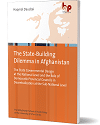 The State-Building Dilemma in Afghanistan.
The State-Building Dilemma in Afghanistan.
The State Governmental Design at the National Level and the Role of Democratic Provincial Councils in Decentralization at the Sub-National Level
by Haqmal Daudzai
About the book
After nearly two decades of war, on February 2020, the Trump administration signed an agreement with the Taliban through which the US and its NATO allies’ troops must leave Afghanistan within the following few months. This agreement also paves the ground for Intra-Afghan talks between the US backed Islamic Republic of Afghanistan and the Taliban militant group. Haqmal Daudzai critically reviews the US/NATO military, peace-and-statebuilding intervention since 2001 in Afghanistan. In addition, based on collected field interviews, he presents the Afghan perception and discourse on the topics such as democracy, Islam, women rights, formal and informal governance, ethnic divide and the state democratic governmental design at the national and subnational level.
Reading sample: pp. 127-133
Chapter 6: A Critical Analyses of the U.S. Post-Taliban Intervention in Afghanistan (2001-2014)
6.1 The U.S. Post-Taliban Nation and Statebuilding Intervention
It would be unfair to deny that the U.S.-led military intervention and the subsequent nation-and state-building mission not only ended the Taliban authoritarian and oppressive regime but also introduced Afghanistan to a democratic government for the first time in its history. They also brought a constitution that guarantees an elected government through free and fair election; equal rights and opportunities for all citizens including women; freedom of expression and civil society. Yet it is equally fair and significant to highlight the U.S. intervention’s flaws, in some instances, unfixable ones, that led to the loss of hundred-thousand human lives and billions of U.S. dollars’ worth of resources, and more importantly continued conflict in Afghanistan. The United States post-9/11 military intervention in Afghanistan could be primarily justified by reason of ‘self-defense’ and ‘security’ conditions, according to Adelman (2002), Talentino (2005), and Heinze (2009). The Taliban Emirate’s refusal to hand over the 9/11 suspect Usama bin Laden – leader of the Al-Qaida extremist organization– led the U.S. to embark on the war on terror on Al-Qaida and on the Taliban for providing it sanctuary in Afghanistan.
Another rational for the U.S. invasion, according to Heinze (2009), calls on the cosmopolitan theory’s moral reasoning which justifies international intervention with military force where a state or regime inflicts human suffering on its own people (p. 16). That argument had been made even prior to the 9/11 incident, and the Taliban regime was already under scrutiny by international forces with an eye to possible intervention because of its violent and oppressive rule and human rights violations on its own people, including the ban on women’s education.
Furthermore, according to Talentino (2005), the contemporary concept of ‘security’ in international politics encompasses a large list of issues including health, migration, gender, environment, and terrorism. Adelman (2002) & Talentino (2005) argue that the failure of a state in ensuring the basic needs of its own citizens – including security, health, education, economic opportunities, and the rule of law – eventually jeopardizes the security and well-being of citizens of another state. Thus, it is at this juncture that the ‘self-defense’ military intervention reason extends to the wider ‘security’ concept and justifies state-building engagements in failing and failed states, or in ‘no state’ circumstances, as was the case in Afghanistan after the Taliban was ousted. The state-building intervention was in dire need in Afghanistan even prior to 9/11.
When the Bush administration declared its war against terror, no intention and plan was in place for a subsequent nation and state-building intervention in Afghanistan (Rashid, 2008/2009). The Bonn process was aimed to fill the power (Rashid, 2008/2009) created by the Taliban removal. Additionally, it is important to note that, before the U.S. invasion, Afghanistan did not have a functioning state as was the case in Iraq, Japan, and Germany (Monten, 2014, pp. 185-186). Due to decades long war and conflict (discussed in the earlier section), the state-machinery was so severely damaged that it was barely able to deliver even basic services (e.g., security, water, shelter, health, education, and the rule of law) to its people. One quarter of the Afghan population had migrated (Rashid, 2008/2009), the rest were in captivity either to the strict Sharia law of the Taliban Emirate or to the savage brutality of the Northern Alliance warlords. Since the arrival of the warlords in 1990s, the Afghan informal governance structures, which had proved successful in resolving community conflicts, and had often played a mediating role between the state and society in the past, were also disrupted. As the well-known scholar on Afghanistan, Barnett Rubin, noted in an article in 2002, “over the past two decades Afghanistan has been ruled, in whole or in part, at times badly and at times atrociously, but it has not been governed” (2002, p. 153). Likewise, the illicit economy –comprised of poppy cultivation, drug-trade, and the illegal export and import of other goods– primarily benefited the conflict parties and mafia groups (Rubin, 2002). In short, Afghanistan matched all the tags of a ‘fragile state’ listed by Olivier Nay (2012, p. 2) as weak, failing, failed, collapsed, and divided, and in dire need of the establishment of a sustainable peace and the creation of new state security, political, administrative, and economic institutions.
The focus of this discussion is not whether the U.S. military intervention in Afghanistan was morally justifiable or not. Rather it describes the basis of the arguments for the subsequent nation and state-building engagement of the international community in general, and of the U.N. and the U.S. in particular.
In other words, state-building by an external interventionist and its local legitimacy are the main themes of this discourse. As Marina Ottaway (2002) notes, the challenging task for third party state-builders is not the creation of states but the creation of local legitimacy. Chesterman et al. (2004) write:
“States cannot be made to work from the outside. International assistance may be necessary, but it is never sufficient to establish institutions that are legitimate and sustainable. This is not an excuse for inaction, if only to minimize the humanitarian consequences of a state’s incapacity to care for its vulnerable population. Beyond that, however, international action should be seen first and foremost as facilitating local processes, providing resources, and creating the space for local actors to start a conversation that will define and consolidate their polity by mediating their vision of a good life into responsive, robust, and resilient institutions.” (pii)
If third-party intervention is legitimate for the sake of international security, then it is rational to subject the interventionist/s to scrutiny of the outcomes of their state-building mission. Heinze (2009) also believes that any intervention is subject to moral, legal, and political questions. The current chapter will critically analyze the U.S. post-9/11 military invasion and its subsequent nation and state-building intervention that shaped the Bonn agreement and the ongoing state apparatus in Afghanistan.
6.2 The Bonn Agreement and Its Unfixable Flaws
In late November 2001, while the U.S. and its local ally – the Afghan Northern Alliances – forces were still hunting Al-Qaida and Taliban forces in Afghanistan, the United Nations Security Council issued resolution ‘1378’, convening a conference in Bonn, Germany, to establish a ‘transitional administration leading to the formation of a new government’ in Afghanistan (United Nations Security Council , 2001, p. 2). In Afghanistan, from 1994 until the invasion of the U.S. in late 2001, the Taliban and the Northern Alliances warlords were the main conflict parties, whose armed forces fought each other on the frontlines. Once hostile to each other, the Northern Alliances– an ethnic collation of Tajik Jamiat-e-Islami ‘Islamic Society’ party under Burhanuddin Rabbani, the Panjshiri24 Shura-e-Nezar party ‘supervisory council of the north’ under Ahmad Shah Massoud, the Hazara Wahdat-e-Islami ‘Islamic Unity’ party led by Abdul Ali Mazari and the Jumbish-e- Mili of General Dostum – was formed after the capture of Kabul by the predominantly Pashtun movement of the Taliban in September 1996 (Collins, 2011, p. 38).
The initial outcome of the December 5th, 2001 Bonn agreement, also known as the Bonn Accord, was the formation of a six-months transitional government, also known as the Interim Authority of Afghanistan (Rubin, 2004). The Interim Authority of Afghanistan was supplemented by a supreme court and a commission for facilitating the inauguration of an Emergency Loya Jirga, or grand council, that would lay the foundation for a future complete and ‘permanent’ government’s ‘structure and key personnel’ (Rubin, 2004).
The Bonn agreement was followed by some state-building (institution building) efforts which were principally a nation-building attempt – imposed on the warring factions, who hardly represented the Afghan broader population. The Interim Authority of Afghanistan was an ethnopolitical power-sharing deal between two parties, the NA warlords, and the exiled exking Zahir (Rubin, 2004). Thus, the key government positions were also divided based on ethnolinguistic political leaders of Pashtun, Tajik, Hazara and Uzbek.
It was the miscalculated state and nation-building policies and strategies of the Bonn Accord that led to the longest ongoing U.S. war, the extended Afghan conflict and government instability, and widespread corruption in Afghanistan. To mention Berit Beliesemann de Guevara’s (2012) perspective on ‘international state-builders’, in this case the U.S. and the ‘local recipients’, the Afghan conflict parties into consideration here (p. 5). According to Beliesemann de Guevara (2012), while imposing western style statebuilding policy and practices– these include: liberal peace, democracy, governance, internationalization, and depoliticisation – the international statebuilders often ignores the local historical context and sociopolitical dynamics of a country that are very critical to the questions of legitimacy and the political stability of a state. In Afghanistan, the fundamental flaws began with the November 14th, 2001 United Nation’s Security Councils’ nation- and state-building arrangements (United Nations Security Council , 2001). By excluding one of the critical conflict parties, namely the Taliban, from the negotiations, the Bonn agreement failed to conduct peace-making arrangements. It also failed to ensure a fair representation of the largest ethnic group of Pashtuns in the new government architecture. As Rubin (2004), author on Afghanistan and diplomat at the Bonn talks, confesses “despite this attempt (bringing exiled Pashtuns) at ethnic inclusiveness, the group assembled in Bonn did not represent the people of Afghanistan, either directly or indirectly” (p. 7). Thus, it not only significantly undermined the Bonn process, but it paved the ground for the revival of the Taliban as an insurgency group and the consequent destabilization of the country in the following years. The cause and consequences of the failure of the Bonn peace-making are discussed in detail under a separate title in this chapter.
The Afghan population, which was exhausted from decades of war and forced migration, hoped that maybe this time the United States would save their future by bringing a sustainable government. However, the U.S. along with its U.N. organizers primarily focused on how to fill the power gap left by the Taliban regime. There was fear that the Northern Alliances inner factions would re-enter the conflict for power as had happened during the early 1990s, when the Mujaheddin committed horrific human crimes in the Kabul. There was no guarantee that history would not repeat itself (Rubin, 2004), and although Kabul remained safe, shortly after the fall of the Taliban regime, Balkh province experienced several clashes over the Mazar-e-Sharif city between the Jamiat-e-Islami militia of commander Atta Mohammad Noor and the Jumbish-e-Islami of General Abdul Rashid Dostum. This danger led the U.N. to send its first peacekeeping mission of International Security Assistance Force (ISAF) in January 2002, and by May the same year U.N. forces comprised around 4500 soldiers from nearly 19 nations (Lansford, 2012, pp. 56-57).
The U.N., as the facilitator of the Bonn process, also failed to play its significant role, due to the overall control of the United States over the Bonn process. Chaired by the U.N. special representative for Afghanistan, Lakhdar Brahimi, the key architects and controllers of the Bonn process were U.S. special envoys, James Dobbins and Zalmay Khalilzad, who aimed to reach some quick and reasonable consensuses between the Afghan warlords and Zahir Shah’s team through a policy of reward and threat (Khalilzad, 2016, pp. 119-127).
Moreover, the Bush invasion of Iraq in 2003 considerably reduced the amount of U.S. attention and resources available to the barely began statebuilding mission in Afghanistan (Rubin, 2002), (Rashid, 2010) & (Maley, 2013). Following the Bonn agreement, Afghans awaited some vital infrastructure projects and programs from the newly U.S.-backed government which could have created millions of jobs to the war-torn population while restoring agriculture and building industrial sectors. It was a lost chance, through which the U.S. could have helped the Afghan government gain public support and legitimacy after decades of long war and devastation. However, instead, to cut short their burden of responsibility, the Americans supported the Northern Alliances warlords – who still maintained their militiamen in the regional power-bases – with the U.S. pouring financial and military resources their way, ostensibly to help them fight the remnants of the Al-Qaida and the Taliban (Forsberg, 2009). While the ISAF mission was limited only to the capital Kabul, the rest of the country remained contested among various warlord militia (Rashid, 2010). To sustain their income, the various warlords’ groups turned to the drug-trade and opened other illicit businesses in the areas of their influence (Rashid, 2010) & (Jackson, 2015). In a very short period, they became wealthy and influential enough to threaten the Americaninstalled government in Kabul. According to Rashid (2010), in later years, the Americans accepted that substituting warlords for the Taliban was a fatal mistake. The de-facto control of the warlords in five major provinces is empirically assessed in the following section.
There is no doubt that the U.S. government faced enormous public pressure to respond to the 9/11 perpetrators promptly and accordingly. However, the lack of a policy after ‘the war on terror’ in Afghanistan not only dragged the U.S. into its history’s longest war, causing the loss of hundreds of thousands of human lives and billions of US dollars, but it also made circumstances even bloodier and more complicated for the Afghans than they had been in the first place.
Moreover, in 200l there was a regional and international census on the U.S. intervention in Afghanistan. Nevertheless, as the U.S. showed its intention for longer mission than just removing the Taliban, it significantly alerted the regional powers for their own interests particularly Russia and Iran.
The exclusion of the Taliban from the peace talks, the empowerment of warlords and mafia groups, the de-facto formation of an ethnopolitical powersharing government, and the underestimation of the interests of the regional powers (Pakistan, Iran, Russia, and India) are some of the critical failures of the U.S. led nation- and state-building mission in Afghanistan, discussed separately in the following.
___
24 Panjshir is a Tajik speaking province in north-central Afghanistan. It is the birthplace of Ahmad Shah Massoud, the late leader of the Shura-e-Nezar party or the supervisory council of the North. Since the leadership of the Shura-e-Nezar mainly comprised individuals from Panjshir province, therefore it is popularly referred to as the ‘Panjshiri’ party.
Order now via Budrich webshop
 Haqmal Daudzai: The State-Building Dilemma in Afghanistan
Haqmal Daudzai: The State-Building Dilemma in Afghanistan
Schriften der Willy Brandt School of Public Policy at the University of Erfurt
© Unsplash 2021 / image: WantTo Create

